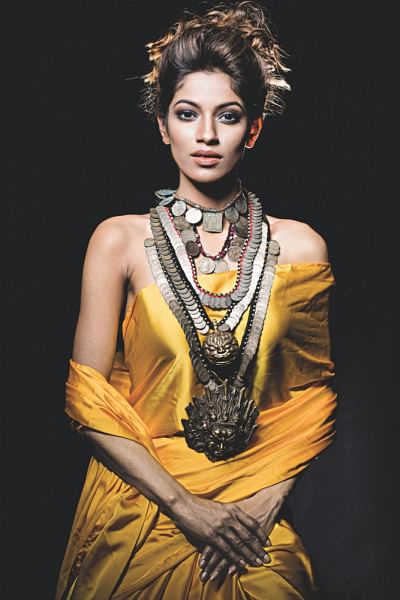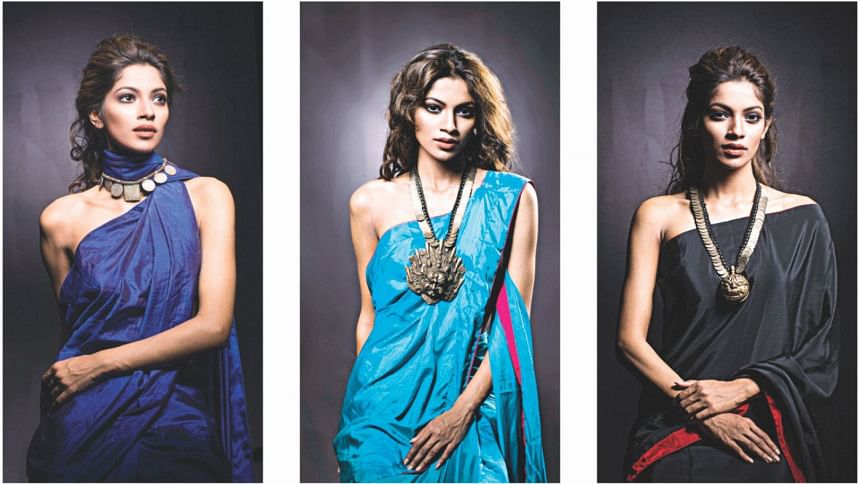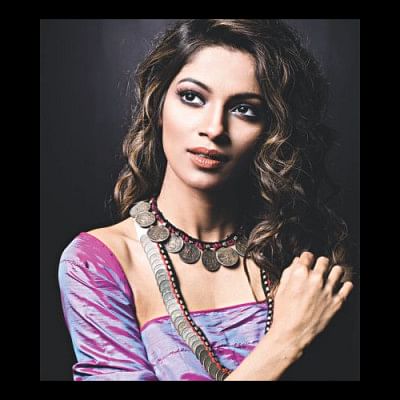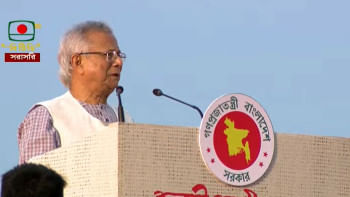Minted bling

An old dented jolly tin box, a lock of hair, a torn sari anchal, a tiny note from a mother to her son in a hostel, and a copper half pice Victorian Indian coin from the 1900s; that's the closest I got to my grandmother while cleaning my father's almirah.
The aged, oxidised copper coin with a beautiful ornamental vine surrounding the queen held my attention. More so, because I saw my Bubu, as I called my maternal grandma, wearing a similar copper coin in her gold chain, and something about the vine was wistful.
Why copper and not a gold guinea I asked, and she replied — 'copper has healing powers'.
Whatever the case, and whatever the metal or alloy — gold, silver or copper, or bronze bullion coins took my fancy. And being a jewellery afficionado and not a coin collector, I made a pendant out of that half-pice, and took my Bubu's coin as well. And as if by some uncanny coincidence, my mother-in-law gave me a gold coin as 'ashirbaad' or blessings when she first met me. Of course, that too has been 'accessorised.'
IN ANCIENT LANDS
Jewellery has been with us since the dawn of civilisation, and it would not be an exaggeration to say that the arts and the crafts that later became jewellery are all signs of prosperous and advanced people.
The practice of making jewellery from coins is well documented in the annals of human history, and museums across the globe now have, on display Egyptian, Greek, and Roman coins, fashioned in forms of fashion accessory.
One does not need to go globe-trotting to trace this trend; coins in the form of jewellery has been found in archaeological excavations on our own native soil, and are on display in museums.
Why were people so smitten by coin jewellery? Well, the answer to that is not so simple. Vanity came into play; possibly carrying a locket made from precious metal was one way of carrying assets from one place to another. Or, there could have been other reasons that are yet to be deciphered.
While scholars argue over why and how this coin-jewellery obsession started, it is well documented through the ages till the Victorian times (1837 – 1902), when the madness really gripped English society, and the lands that the Brits colonised.

VICTORIAN TRENDSETTERS
One may reasonably hope that as the trend of turning coins into jewellery took flight in the latter half of the nineteenth-century, they are widely available; the matter is far from the truth.
Original pieces of Victorian jewellery fetch high prices whenever they come on the market; the more affordable versions that we see are made from Victorian coins, but the design was done much later. Some are simply made from silver replicas, or are even cheap imitations.
One does need to be a connoisseur to spot the difference, but going for the real McCoy's of that era is not for the fainthearted and certainly needs a deep pocket to back up the pursuit.

THE DESHI CONTEXT
The trend of turning coins into jewellery perhaps in Bangladesh too began in the Victorian era, and its charm has survived the 'taste' of time.
It is quite evident that the fashion palate of fashionistas has developed over the ages.
When passing over of legacy from one generation to another, quite frequently, it includes one or two coin pieces that were turned into a necklace. Some are of precious gold, but here, the trend was of silver, as that was more widely used in this part of the region.
The concept of chunky jewellery into the local fashion scene is a relatively new one, and in all possibility, it began as Bangladeshi tourism really took off, and travellers visiting Nepal or Bhutan wanted to bring back souvenirs of those places when they returned.
To meet this new demand, jewellery shops, particularly those on social media, really gave the nudge that was necessary, and we now see myriad forms of jewellery, made from or using coins.
THE FAD
Coins have been clobbered to create jewellery pieces since the practice of using metal as currency began. Today, like in the days of the past, common old coins in denominations of various paisa values has been favourites for making ethnic jewellery and keeping the vintage era alive.
These old coins are being reused and revamped by punching dents and cavities in them to create stunning pieces of adornments such as necklaces, bracelets, waist belts, earrings and even rings, brooches, cufflinks and buttons for an exquisite look. The use of black or coloured rustic style of threading adds to the pieces an extra uniqueness.
Coin jewellery can be teamed up with Western attire to get that perfect Bohemian style. Armlets, big chunky necklaces, and waist belts are all in vogue, and look extremely stylish with long flared Indian skirts, or perhaps Western wear.
On the other hand, gold coin jewellery imparts a very traditional look and is the perfect accompaniment to traditional attire.
From Victorian trinkets to trendy carat gold, one of the most interesting aspects of examining the wide world of coin jewellery is the veritable variety of styles, materials, and emotions behind these vintage pieces. There's something out there to appeal to most jewellery collectors and coin aficionados alike.
However, one word of caution — it is strictly not legal to turn coins into jewellery, until and unless they are demonetised. So, if you were thinking of turning that old one paisa of Bangladesh into an elegant piece, we would say, stick to the ones that have lost their value, but gained their charm.
— RBR and MMZ
Photo: Sazzad Ibne Sayed
Model: Surjo
Jewellery: Kolors of Kathmandu
Makeup: Farzana Shakil's Makeover Salon
Styling: Sonia Yeasmin Isha

 For all latest news, follow The Daily Star's Google News channel.
For all latest news, follow The Daily Star's Google News channel. 



Comments